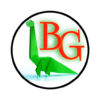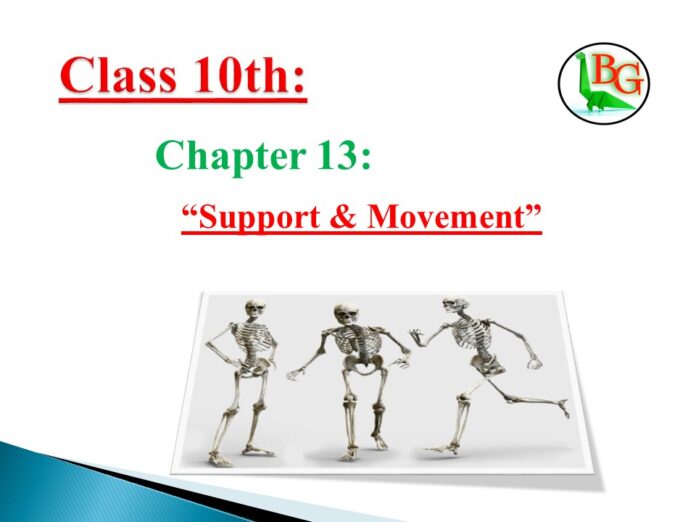Class 10th Biology MCQs & Questions
Chapter: 13
“Support and Movement”

1. The movement of an animal as a whole from one place to another is called
a) Movement
b) Locomotion
c) Circulation
d) None of the above
Sol: (b) Locomotion
2. The skeleton provides
a) Physical support
b) Protection
c) Attachment of skeletal muscles
d) All of these
Sol: (d) All of these
3. The skeleton which is found inside the body is called
a) Exoskeleton
b) Endoskeleton
c) Both
d) None of the above
Sol: (b) Endo-skeleton
4. A dense, clear blue-white firm connective tissue (but less strong than bone) called
a) Matrix
b) Cartilage
c) Ligaments
d) Bone
Sol: (b) Cartilage
5. The cells of cartilage are called
a) Matrix
b) Collagen fibres
c) Chondrocytes
d) Osteocytes
Sol: (c) Chondrocytes
6. A fluid space present in the matrix of cartilage called
a) Collagen fibres
b) Flexor
c) Lacuna
d) All of these
Sol: (c) Lacuna
7. Which type of cartilage is found at the ends of tbol dosage the long bones, nose, and larynx?
a) Elastic cartilage
b) Fibrous cartilage
c) Hyaline cartilage
d) Cricoid cartilage
Sol: (c) Hyaline cartilage
8. The cartilage that is found in intervertebral discs is called
a) Fibrous cartilage
b) Elastic cartilage
c) Hyaline cartilage
d) None of the above
Sol: (a) Fibrous cartilage
9. The harder outer layer of a bone is called
a) Spongy bone
b) Compact bone
c) Flat bone
d) Irregular bone
Sol: (b) Compact bone
10. The interior of bone that is soft and porous is called
a) Spongy bone
b) Compact bone
c) Short bone
d) Cortical bone
Sol: (a) Spongy bone
11. Babies are born with almost……….bones.
a) 206
b) 300
c) 304
d) 200
Sol: (b) 300
12. How many bones the adult has?
a) 300
b) 206
c) 306
d) 200
Sol: (b) 206
13. The mature bone cells are called
a) Osteoblast
b) Osteoclast
c) Osteocytes
d) All of the above
Sol: (c) Osteocyte
14. Axial skeleton consists of ……….bones.
a) 90
b) 80
c) 70
d) 65
Sol: (b) 80
15. How many bones are cranial?
a) 8
b) 22
c) 14
d) None of the above
Sol: (a) 8
16. Hyoid bone found in
a) Lungs
b) Arms
c) Fingers
d) Neck
Sol: (d) Neck
17. How many facial bones are?
a) 8
b) 14
c) 12
d) 16
Sol: (b) 14
18. How many pairs of rib bones?
a) 11 pairs
b) 12 pairs
c) 13 pairs
d) 10 pairs
Sol: (b) 12 pairs
19. The chest bone is called
a) Sternum
b) Ossicles
c) Hyoid bone
d) None of the above
Sol: (a) Sternum
20. How many bones are present in the appendicular skeleton?
a) 126
b) 125
c) 124
d) 123
Sol: (a) 126
21. How many bones are present in the left hand?
a) 54
b) 24
c) 27
d) 28
Sol: (c) 27
22. Legs have ………bones.
a) 6
b) 8
c) 10
d) 4
Sol: (a) 6
23. The longest bone in the human body
a) Thighbone
b) The femur
c) Both (a) and (b)
d) None of the above
Sol: (c) Both (a) and (b)
24. The smallest bone in the human body.
a) Stapes
b) Hyoid bone
c) Hammer
d) Incus
Sol: (a) Stapes
25. How many bones make our skull?
a) 24
b) 22
c) 26
d) 20
Sol: (b) 22
26. The location at which two or more bones make contact is called
a) Ball-and-socket joint
b) Joint
c) Hinge joints
d) Moveable joints
Sol: (b) Joint
27. The joints between the skull bones are called
a) Fixed joints
b) Immoveable joints
c) Slightly moveable joints
d) Both (a) and (b)
Sol: (d) Both (a) and (b)
28. The shoulder joint, hip joint, knee joint, and elbow joints that allow a variety of movements are called
a) Moveable joints
b) Slightly moveable joints
c) Hinge joints
d) Fixed joints
Sol: (a) Moveable joints
29. The type of joints that move back and forth and movements in one plane only is called
a) Hinge joints
b) Ball-and-socket joints
c) Fixed joints
d) Moveable joints
Sol: (a) Hinge Joints
30. The type of joints that allow movement in all directions are called
a) Hinge joints
b) Moveable joints
c) Ball-and-socket joints
d) Fixed joints
Sol: (c) Ball-and-socket joints
31. A connective tissue that attaches muscle to bone is called
a) Ligaments
b) Tendons
c) Bone marrow
d) Flexor
Sol: (b) Tendons
32. A connective tissue that attaches bones to bones is called
a) Ligaments
b) Tendons
c) Origin
d) Flexor
Sol: (a) Ligaments
33. The end of a muscle that attaches to immoveable bones is called
a) Insertion
b) Origin
c) Antagonist
d) Flexion
Sol: (b) Origin
34. The end of a muscle that attaches to moveable bones is called
a) Insertion
b) Origin
c) Flexion
d) Extension
Sol: (a) insertion
35. Pairs of muscle that work against each other are called
a) Ligaments
b) Tendons
c) Antagonist
d) None of the above
Sol: (c) Antagonist
36. When a muscle contract and bends the joint, it is called
a) Flexor
b) Extensor
c) Insertion
d) Origin
Sol: (a) Flexor
37. When a muscle contracts and straightens the joint, it is known as ……..muscle.
a) Extensor
b) Flexor
c) Origin
d) Insertion
Sol: (a) Extensor
38. Muscles can only………
a) Contract
b) Pull
c) Push
d) Both (a) and (b)
Sol: (d) Both (a) and (b)
39. Disease of bones due to the loss of calcium, phosphorus and malnutrition or deficiency of estrogen hormone,
a) Osteoporosis
b) Osteo-arthritis
c) Gout
d) Rheumatoid arthritis
Sol: (a) Osteoporosis
40. Inflammation in joints is called
a) Osteoporosis
b) Arthritis
c) Osteocytes
d) Chondrocytes
Sol: (b) Arthritis
41. The inflammation of the membranes at joints is called
a) Arthritis
b) Rheumatoid arthritis
c) Osteo-arthritis
d) Gout
Sol: (b) Rheumatoid arthritis
42. Rheumatoid arthritis include
a) Fatigue
b) Low-grade fever
c) Stiffness in joints
d) All of these
Sol: (d) All of these
43. The disease in which the accumulation of uric acid in moveable joints is called
a) Gout
b) Rheumatoid arthritis
c) Osteoporosis
d) Osteo-arthritis
Sol: (a) Gout
44. What do some bones produce?
a) Mucous
b) Blood cells
c) Hormones
d) Oxygen
Sol: (b) Blood cells
45. The purpose of the rib cage is to
a) Protect the stomach
b) Protect the spinal cord
c) Protect the heart and lungs
d) Protect the skull
Sol: (c) Protect the heart and lungs
Important definition in this chapter:
Define locomotion
Define skeleton
Define chondrocytes
Define osteocytes
Define antagonism
Define hinge joints
Define arthritis
What is Gout
Define lacuna
Class 10th biology, chapter 13, support, and movement MCQs
Important Short Questions in this chapter:
1. Difference between an exoskeleton and an endoskeleton?
2. Difference between movement and locomotion?
3. Difference between cartilage and bone?
4. What are the types of cartilage?
5. Difference between ligaments and tendons?
6. Difference between compact and spongy bone?
7. Difference between the hinge and ball-and-socket joints?
8. Difference between flexion and extension?
9. Difference between osteoarthritis and rheumatoid arthritis?
10. Difference between biceps and triceps?
11. Explain the axial skeleton.
Related articles:
Facts about animals
Wildlife terminologies



nice
Zoologist
You are doing great girl/boy.
Good work… 44 right from 50 !
Thanks sir for your time and effort. Allah bless you